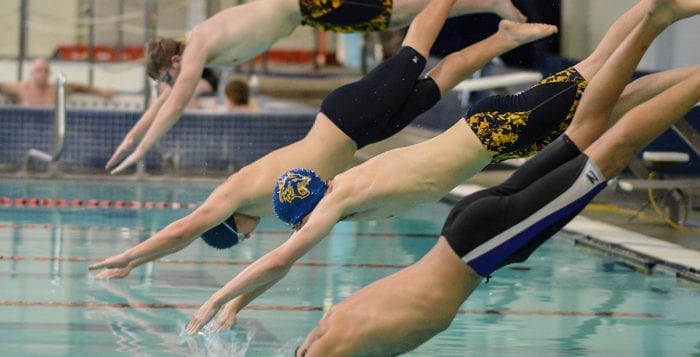D. None of the Above: Swimming away from high school problems

We think we know our kids, but really the converse is true.
My son recently told me that he thinks I’m angry every time I swim laps in a pool. At first, I dismissed the observation because swimming brings me peace.
And then I thought about my junior year of high school, when I joined my one and only swim team.
I loved the water, I had a few friends on the team and I was determined to do something different when each day in school felt like a bad version of “Groundhog Day,” long before the Bill Murray film arrived in theaters.
I had several shortcomings. For starters, I didn’t know how to do a flip turn. To the experienced swimmer, that’s as laughable as asking a NASCAR driver how to change gears or a baseball player which end of the bat to hold. It’s a basic skill. I’d approach the wall, gasping for air, roll to my right and kick hard.
Most of the time, I’d slam my foot into the lane marker and, on occasion would kick the poor swimmer in lane 5. I swam in lane 6, which was where swimmers who needed life jackets trained. The best swimmers occupied lane 1. They never seemed to need a breath, had hydrodynamic bodies that made them look like torpedoes and seemed slightly bored after an exhausting practice.
Oh, and they also wore Speedo bathing suits well. For someone accustomed to the boxing trunk bathing suits that I still wear today, Speedos seemed way too small. Besides, I’m not sure the small, colorful lightweight suits allowed me to shave even a tenth of a second off my barge-floating-downstream speed.
Each practice, the coach would tell us to swim 20 laps back and forth as a warm-up. By the end of the warm-up, which I never finished, we started practice. At that point, I was leaning hard on the wall, wondering whether I should climb out of the pool and grab some French fries.
When we dove off the blocks at the start of the race, I must have entered the water at the wrong angle. My goggles scraped down my nose and landed in front of my mouth, which made it impossible to see or breathe. Flopping blindly, I’d zigzag in slow motion across the pool.
Each practice completely drained me. My exhausted arms pulled through the water, splashing where others were gliding. My legs slapped at the water, instead of serving as propellers. And yet, something about the incredible energy required to survive each practice helped me, both mentally and physically.
I’m sure I lost weight. After all, such inefficient swimming burns off considerably more calories than floating effortlessly hither and yon. More importantly, though, I worked out everything that bothered me in my head as I listened to the gurgling noises my mouth made while I wiggled back and forth. Each lap, I replayed conversations that went awry, standardized tests that were like electroshock therapy and the missed social opportunities.
Gnashing my teeth, I worked out frustrations that built up during the day or the week. The herculean effort either removed toxins or prevented them from cluttering my brain. Sitting in my room at home after practice, I felt more at peace than I had at any point during the day.
But what my son must have perceived as I do laps today are the habits I formed during that winter season. My body instantly remembers how to use swimming to release tension. He may see the residual physical manifestations of the cauldron of emotions that I carried back and forth across that icy pool. And, hey, maybe I’d look like a happier swimmer if I ever learned how to do a flip turn.







